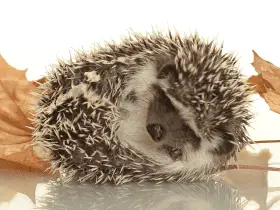Are you considering getting a pet hedgehog? We understand that some may be hesitant due to concerns about potential threats and dangers. However, fear not! In this article, we will guide you through identifying common threats to pet hedgehogs and provide you with practical tips on how to avoid them.
From health risks and dangerous foods to creating a safe habitat, we’ve got you covered. So, let’s dive in and ensure the well-being of our adorable spiky companions together!
Key Takeaways
- Regularly clean the enclosure and provide fresh bedding to promote a clean and healthy living environment.
- Keep electrical cords hidden or covered with protective tubing to prevent hedgehogs from chewing on them and risking electric shocks or fires.
- Avoid feeding hedgehogs chocolate, caffeine, onions, and grapes as they can cause gastrointestinal issues, organ damage, or even death.
- Research and identify any potentially harmful plants in your home or garden to keep your hedgehog safe.
Health Risks for Pet Hedgehogs
Pet hedgehogs can be susceptible to a variety of health risks if proper care is not taken. As responsible hedgehog owners, it’s important to prioritize their hygiene and exercise requirements.
Maintaining good hedgehog hygiene is essential for preventing various health issues. Regularly cleaning their enclosure, removing waste, and providing fresh bedding are crucial steps in promoting a clean and healthy living environment. Hedgehogs should also receive regular baths to keep their quills free from dirt and debris. It’s important to use lukewarm water and mild, hedgehog-safe shampoo during these baths.
Exercise is vital for the overall well-being of pet hedgehogs. These active little creatures need ample opportunities to explore and move around. Providing them with an appropriately sized exercise wheel or allowing supervised playtime outside their enclosure will help prevent obesity and maintain healthy muscle tone.
Potential Hazards in the Hedgehog’s Environment
Keep an eye out for potential hazards in your hedgehog’s environment. As responsible pet owners, it is our duty to ensure the safety and well-being of our beloved hedgehogs. There are several environmental dangers that we need to be aware of in order to protect our little friends.
One potential hazard is electrical cords. Hedgehogs have a curious nature and may chew on cords, leading to electric shocks or even fires. It is crucial to keep all cords hidden or covered with protective tubing.
Another threat is household chemicals. Cleaning products, insecticides, and certain plants can be toxic if ingested by hedgehogs. Make sure these items are securely stored away from their reach.
Sharp objects such as needles, pins, or broken glass should also be kept out of their habitat as they can cause serious injuries if accidentally stepped on or ingested.
Additionally, temperature extremes can pose a risk to hedgehogs. They prefer temperatures between 72-80°F (22-27°C) and can suffer from heatstroke or hypothermia if exposed to extreme heat or cold for prolonged periods.
Lastly, secure all doors and windows properly as hedgehogs are excellent climbers and escape artists. Always supervise them during playtime outside their enclosure to prevent potential accidents.
Dangerous Foods for Hedgehogs
When it comes to our hedgehog’s diet, it’s important to be aware of the toxic food items that could potentially harm their health. Some common foods that are dangerous for hedgehogs include chocolate, caffeine, onions, and grapes. Consuming these toxic foods can lead to potential health risks such as gastrointestinal issues, organ damage, and even death.
It’s crucial for hedgehog owners to educate themselves on safe dietary alternatives and provide a balanced diet consisting of appropriate fruits, vegetables, protein sources, and commercial hedgehog food.
Toxic Food Items
It’s important to be aware of toxic food items that could harm your hedgehog. As responsible pet owners, we must ensure the safety and well-being of our little spiky friends. Toxic plants are one such threat that can pose a serious danger to hedgehogs if ingested. Plants like azaleas, daffodils, and lilies contain toxins that can cause severe gastrointestinal upset or even organ failure in hedgehogs. To keep your hedgehog safe, it’s crucial to carefully research and identify any potentially harmful plants in your home or garden.
In case of accidental ingestion, immediate action is required. Knowing emergency first aid for hedgehogs is essential. If you suspect your hedgehog has consumed a toxic plant or food item, contact a veterinarian immediately for guidance. Do not induce vomiting unless specifically instructed by a professional as it may worsen the situation. Prompt medical attention can make all the difference in ensuring your beloved pet’s health and happiness.
Potential Health Risks
Make sure to regularly monitor your hedgehog’s health for any signs of potential risks or illnesses. As responsible pet owners, it’s crucial to understand the common illnesses that can affect hedgehogs and take preventive measures.
One of the most prevalent health issues is obesity, which can lead to various complications such as heart disease and diabetes. To prevent this, provide a balanced diet with limited treats and ensure regular exercise.
Another common ailment is dental problems caused by improper chewing surfaces or lack of dental care. Regularly check their teeth and offer appropriate chew toys to maintain oral health.
Respiratory infections are also common in hedgehogs due to their sensitive respiratory systems. Keep their enclosure clean and well-ventilated, avoiding exposure to drafts or extreme temperatures.
Parasites like mites and fleas can cause discomfort and skin issues; therefore, regular grooming and preventative treatments are essential.
Safe Dietary Alternatives
You can provide safe dietary alternatives for your hedgehog to ensure their nutritional needs are met without compromising their health. Here are some options that will keep your hedgehog happy and healthy:
High-quality commercial hedgehog food: Look for a brand that contains essential nutrients like protein, fat, fiber, vitamins, and minerals.
Insects: Hedgehogs love munching on mealworms, crickets, and waxworms. These creepy crawlies provide a good source of protein.
Fruits and vegetables: Offer small amounts of fresh fruits like apples or berries, as well as veggies such as carrots or green beans. These add variety to their diet while providing important vitamins and fiber.
Cooked meats: Occasionally giving your hedgehog cooked chicken or turkey can be a tasty treat while still meeting their protein requirements.
Remember to always consult with a veterinarian experienced in exotic pets to determine the best dietary plan for your individual hedgehog’s nutritional requirements.
Common Parasites and Diseases in Hedgehogs
Take note of common parasites and diseases that can affect your pet hedgehog. As responsible hedgehog owners, it’s crucial to be aware of these potential threats and take preventative measures to keep our little friends healthy and happy.
Parasite prevention is essential for the well-being of your hedgehog. One common parasite that affects hedgehogs is mites. These tiny creatures can cause itchiness, hair loss, and skin irritation in your pet. Regularly checking for signs of mites such as excessive scratching or scaly skin is important. If you notice any symptoms, consult a veterinarian who can prescribe appropriate treatment.
Another common disease among hedgehogs is called Wobbly Hedgehog Syndrome (WHS). This neurological disorder causes progressive muscle weakness and loss of coordination in affected animals. Unfortunately, there is no known cure for WHS, but early detection can help manage its symptoms and improve the quality of life for your hedgehog.
Hedgehogs are also susceptible to respiratory infections, which may result from poor living conditions or exposure to cold temperatures. Keep their habitat clean and provide adequate heating to prevent respiratory issues.
Regular veterinary check-ups are essential in identifying any potential health concerns before they become serious problems. By staying vigilant and taking necessary precautions, we can ensure our beloved pet hedgehogs live long, healthy lives free from common parasites and diseases.
Avoiding Accidental Harm: Handling and Interaction Guidelines
In our previous discussion, we explored the various parasites and diseases that can pose a threat to our beloved hedgehogs. Now, let’s shift our focus towards preventing accidental harm and creating positive interactions with these adorable creatures.
By following proper handling techniques and implementing effective socialization methods, we can ensure the well-being of our pet hedgehogs while fostering a strong bond with them.
Here are some guidelines to keep in mind:
Approach with care: When picking up your hedgehog, approach slowly and gently. Avoid sudden movements or loud noises that may startle them.
Support their weight: Always use both hands to hold your hedgehog securely, ensuring that you provide proper support for their delicate spines.
Respect their personal space: Hedgehogs need time to adjust to new surroundings and human interaction. Give them space when they retreat into their ball form; pushing them out forcefully can cause stress.
Gradual socialization: Start by spending short periods of time together each day, gradually increasing the duration as your hedgehog becomes more comfortable with your presence.
By following these handling techniques and employing effective socialization methods, you can establish trust and create a safe environment for your pet hedgehog to thrive in.
Creating a Safe and Comfortable Habitat for Your Hedgehog
When it comes to creating a safe and comfortable habitat for our hedgehogs, there are several key points to consider.
Firstly, choosing the proper bedding materials is crucial for their well-being. We’ll discuss which options are best suited for hedgehogs and why.
Additionally, maintaining optimal temperature control in their environment is essential to ensure they stay healthy and happy.
Proper Bedding Materials
Using appropriate bedding materials is crucial for ensuring the safety and comfort of your pet hedgehog. Here are four key points to consider when choosing and maintaining bedding for your hedgehog’s habitat:
Natural vs. Synthetic Bedding: Natural bedding options, such as shredded paper or wood shavings, provide a more comfortable and environmentally friendly option for your hedgehog. Avoid synthetic options that may contain harmful chemicals or irritate your pet’s sensitive skin.
Proper Bedding Depth: Ensure that the bedding depth is sufficient to allow your hedgehog to burrow and hide comfortably. Aim for at least 2-3 inches of bedding to provide insulation and promote natural behaviors.
Regular Cleaning: Clean soiled areas daily to maintain a clean and hygienic environment for your hedgehog. Replace dirty or wet bedding promptly to prevent odor buildup and potential health issues.
Bedding Rotation: Regularly rotate the bedding in your hedgehog’s habitat to ensure freshness and reduce the risk of mold or bacterial growth. This will also help keep odors under control.
Optimal Temperature Control
Maintaining the optimal temperature in your hedgehog’s habitat is essential for their well-being and comfort. Hedgehogs are native to warmer climates, so it’s crucial to regulate the temperature in their enclosure.
The ideal temperature range for hedgehogs is between 72°F and 80°F (22°C – 26°C). To achieve this, you can use various heat sources such as heating pads or ceramic heat emitters. These should be placed on one side of the enclosure, allowing your hedgehog to move away if they feel too warm.
It’s important to monitor the temperature regularly using a reliable thermometer. Avoid using heat lamps as they can dry out the environment and pose a fire hazard.
Suitable Hiding Spots
Now that we’ve discussed the importance of optimal temperature control for pet hedgehogs, let’s move on to another crucial aspect of their well-being: suitable hiding spots.
Hedgehogs are naturally shy and nocturnal creatures, and providing them with adequate hiding options is essential for their sense of security and overall happiness.
To create a habitat that closely resembles their natural environment, here are four hiding spot options you can consider:
Tunnel system: Set up tunnels made from PVC pipes or cardboard tubes to mimic the burrows hedgehogs would find in the wild.
Cozy caves: Provide small igloo-like structures or fleece-lined hideouts where your hedgehog can retreat for privacy and comfort.
Stacked shelves: Arrange platforms or shelves at different heights to mimic trees or bushes, allowing your hedgehog to climb and explore.
Leaf piles: Scatter dried leaves (from non-toxic plants) in a designated area, creating a natural leaf pile where your hedgehog can snuggle in.
Preventing Escape and Ensuring Hedgehog Security
To keep your pet hedgehog secure and prevent escape, it’s important to create a habitat with no gaps or openings. Hedgehogs are curious creatures that love to explore, so ensuring their enclosure is escape-proof is crucial for their safety.
Start by selecting an appropriate enclosure that provides ample space for your hedgehog to roam around comfortably. Choose one made of sturdy materials like plastic or metal, as these will prevent any potential escape attempts.
Inspect the entire enclosure carefully, paying close attention to corners, edges, and any small crevices where your hedgehog could squeeze through. Seal off any gaps using pet-safe silicone or covers specifically designed for hedgehog enclosures. Ensure all doors and latches are secure and cannot be easily opened by a determined hedgie.
Additionally, avoid placing the enclosure near furniture or other objects that could provide leverage for climbing out. Keep in mind that hedgehogs are skilled climbers and can use various objects as stepping stones to freedom.
Regularly check the enclosure for wear and tear, making necessary repairs immediately. Remember, prevention is key when it comes to keeping your beloved pet safe from potential escapes.
Frequently Asked Questions
Can Hedgehogs Be Kept as Outdoor Pets?
Yes, hedgehogs can be kept as outdoor pets. However, it is important to provide them with a suitable hedgehog outdoor enclosure and take necessary hedgehog outdoor safety precautions to ensure their well-being.
What Are Some Common Signs and Symptoms of Illness in Hedgehogs?
Warning signs of illness in hedgehogs can include changes in appetite, behavior, and appearance. It’s important to seek veterinary care promptly when these signs are observed to ensure the health and well-being of our beloved pets.
Are There Any Specific Plants That Are Toxic to Hedgehogs?
Yes, there are specific plants that can be toxic to hedgehogs. It’s important to know which ones to avoid when creating a hedgehog-safe garden. Here are some ideas for creating a safe environment for our prickly friends.
Can Hedgehogs Catch Diseases From Other Household Pets?
Yes, hedgehogs can catch diseases from other household pets. It’s important to be aware of disease transmission risks and take preventive measures such as regular vet check-ups and keeping pets’ vaccinations up-to-date.
How Often Should Hedgehogs Be Taken to the Vet for Check-Ups?
We should take our hedgehogs to the vet for check-ups regularly. It is important to get vaccinations and follow preventative measures to keep them healthy. Regular vet visits help ensure their well-being.
Conclusion
In conclusion, we have explored the various health risks, potential hazards, dangerous foods, parasites, and diseases that can threaten our beloved pet hedgehogs.
By following the guidelines for handling and interaction, creating a safe habitat, and ensuring security measures to prevent escape, we can provide a comfortable and secure environment for our prickly friends.
Remember, it’s our responsibility as owners to educate ourselves about these common threats and take proactive steps to keep our hedgehogs happy and healthy.
Together, let’s make sure our hedgehogs thrive!
















Leave a Reply
View Comments